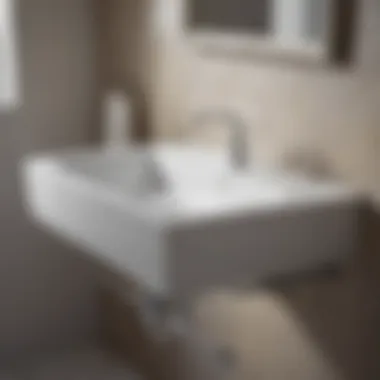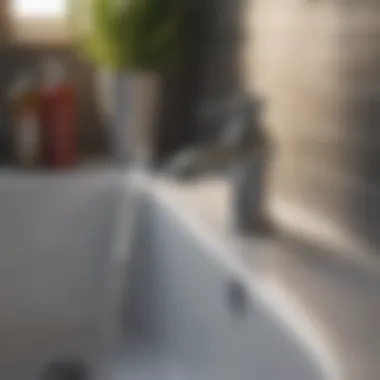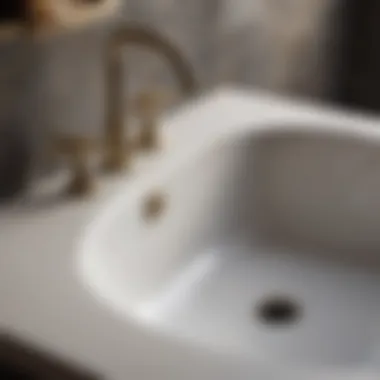Mastering Bathroom Sink Plumbing Diagrams


Intro
With that said, getting familiar with the components and how they interconnect can save you time, money, and a fair share of headaches. This comprehensive guide aims to break down everything you need to know about bathroom sink plumbing diagrams and more.
Materials:
To embark on your plumbing project, you’ll first need to gather the right materials. Here’s a list of what you’ll need, including specific measurements to help you get started:
- PVC pipe (1 1/4 inch diameter) - 5 feet: Used for the drain line.
- PVC pipe (3/4 inch diameter) - 2 feet: For the water supply lines.
- PVC elbows (1 1/4 inch) - 4 units: To change direction in the drain line.
- PVC tee (1 1/4 inch) - 1 unit: To connect multiple lengths of pipe.
- P-trap assembly: This piece ensures smelly gases from the sewer don’t invade your bathroom.
- Angle stop valves (3/4 inch) - 2 units: To control the flow of hot and cold water.
- Flexible hoses (3/4 inch) - 2 units: Connect the angle stops to the sink faucet.
- Sink strainer: Used to prevent debris from clogging the drain.
- Plumber’s putty: Helps seal joints.
- Teflon tape: To ensure leak-proof connections.
Getting the right materials before starting makes the entire plumbing process smoother.
DIY Steps:
Now that you have all the materials ready, let’s get into the actual steps. The installation involves several essential elements—here’s a detailed breakdown:
- Turn Off the Water Supply: Locate your main water supply and shut it down.
- Prepare the Sink Area: Clear out any clutter from under the sink and place a bucket to catch water.
- Install the Sink Strainer: Following the manufacturer’s instructions, place the sink strainer in the drain hole and use plumber’s putty at joints to secure it.
- Set Up the P-trap: Attach the P-trap to the strainer and connect it to the drain line. Ensure everything fits snugly without any gaps.
- Connect the Water Supply: Using angle stop valves, connect the flexible hoses to the main water lines, and attach the other ends to the sink faucet.
- Turn On the Water Supply: Slowly turn the main water supply back on and check for any leaks.
- Testing: Run the water and ensure everything drains properly without any blockages.
Keep in mind that thorough preparations and careful installations will set you up for success.
Technical Aspects:
Understanding the technical aspects can further elevate the quality of your DIY plumbing. Here’s a rundown of useful tools:
- Pipe cutter: Ensures clean cuts on pipes for proper fitting.
- Adjustable wrench: Helps in securing fittings without damaging them.
- Drill/driver: A power tool can speed up fastening processes.
- Measuring tape: Essential for ensuring correct measurements when cutting pipes.
Timing specifics
For an average DIYer, dedicating a weekend (around 3 to 5 hours) should be sufficient for this project.
Critical Techniques
- Test fittings before securing: This allows you to make adjustments easily.
- Use Teflon tape liberally: Don’t skimp on this; it can save from frustrating leaks later.
DIY Project Process:
With your materials in place and a firm understanding of the technical aspects, it’s time to get hands-on with the installation process. Follow these sequential steps for the best results:
- Measure your Space: Make sure your pipes will fit comfortably under the sink.
- Cut Your Pipes: Using a pipe cutter, measure and cut the necessary pipe lengths.
- Assemble the Drain: Begin by assembling the drain components, connecting the P-trap, and ensuring all fittings fit well.
- Mount the Faucet: Place the faucet into the sink, securing it with the provided hardware.
- Connect Water Supply: Attach your hoses from the faucet to the angle stops you installed earlier.
Troubleshooting Tips:
Even the best-laid plans can run into snags. Here are common issues and their solutions:
- Leak at the connections: Retighten the fittings or consider adding Teflon tape for better sealing.
- Sink not draining smoothly: Check for clogs either at the strainer or further down the drain line.
- Water pressure issues: Make sure that the angle stops are fully opened and attach hoses securely.
By sticking to these well-laid plans and practices, you’ll not only enhance your space but also build your confidence in handling similar projects in the future.
Prologue to Bathroom Sink Plumbing
Bathroom sink plumbing might seem a trivial aspect of home design or renovation, but its significance cannot be overstated. It’s a layer of comfort that involves both the aesthetics of your space and its functionality. Think about it—what good is a beautiful sink if the water won’t drain right? Understanding the intricacies of sink plumbing is akin to knowing the melody of your favorite song; without it, the performance falls flat.
By delving into bathroom sink plumbing, we gain the awareness needed for smoother installations and effective maintenance. Familiarity with these systems can save homeowners time, money, and the inevitable headache of dealing with plumbing issues down the road.
So, why bother with plumbing diagrams? They offer a roadmap, guiding us through the maze of pipes, fittings, and fixtures. They illustrate how everything connects, ensuring you know exactly what’s going on behind the scenes—the hidden works that keep your sink operational.
The benefits here are bountiful:
- Avoid costly plumbing mistakes
- Make informed decisions regarding installations and repairs
- Enhance your ability to troubleshoot problems
Indeed, having a grasp of the basic components and their relationships fosters a sense of empowerment. Engaging with plumbing diagrams adds clarity to your understanding. It enables any homeowner to appreciate or even participate in plumbing decisions without feeling lost in a sea of jargon.
In summary, taking the time to understand bathroom sink plumbing not only supports effective usage but also cultivates a profound respect for the craft of plumbing.


Overview of Plumbing Diagrams
When it comes to understanding bathroom sink plumbing, diving into plumbing diagrams is akin to having a roadmap on a journey. These diagrams are essential not only for visualizing the layout of plumbing components but also for grasping how all these elements interact with one another. By familiarizing ourselves with these diagrams, both seasoned plumbers and everyday homeowners can tackle plumbing projects with greater confidence and accuracy.
The value of plumbing diagrams goes beyond just eye candy; they play a crucial role in planning and executing plumbing tasks. With the right diagram in hand, one can better understand the entire system—where water comes from, how it moves, and where it ultimately goes. It lays out a clear picture of the connections between the sink, the drain, and the water supply, which can save a lot of headache down the line.
Types of Plumbing Diagrams
There are several types of plumbing diagrams, each serving a specific purpose. Here’s a quick rundown:
- Isometric Diagrams: These drawings provide a three-dimensional representation of the plumbing system, making it easier to visualize complex arrangements.
- Pictorial Diagrams: More of a straightforward view, showing actual images of components as they might appear in real life.
- Schematic Diagrams: Less about the visual representation and more focused on the functional aspects of the plumbing system. They often highlight the sequence of operations.
These diagrams cater to different needs depending on whether you're a visual learner, need a straightforward overview, or require a more technical understanding of how everything works together.
Understanding Symbols and Notations
Navigating plumbing diagrams can be tricky if you're not familiar with the symbols and notations used. Here are some standard symbols you might encounter:
- Circle with a line through it: Represents a faucet, indicating the water source.
- Square: Often signifies a drain, where wastewater exits.
- Arrows: These show the flow of water, ensuring you understand how it's meant to move through the system.
Learning to read these symbols can enhance your comprehension of a system’s working elements, giving you a clearer picture of how to make repairs or installations. The importance of this knowledge cannot be overstated, as misreading a symbol can lead to major misunderstandings during installation or repairs.
Remember: Having a solid grasp of plumbing diagrams and their symbols may not just save you time but also spare you from costly mistakes.
Key Components of Bathroom Sink Plumbing
When we talk about bathroom sink plumbing, it’s crucial to zero in on the key components that keep everything flowing smoothly. Understanding these elements doesn't just enhance our knowledge; it can save time, money, and a whole lot of headaches in the long run. Knowing what makes up the plumbing system helps in making informed choices during installation, maintenance, and troubleshooting.
In a nutshell, think of plumbing like the veins of your home—everything must work seamlessly to ensure water gets delivered and drains properly.
Faucet Systems
Faucets are one of the most visible parts of sink plumbing, and they play an essential role in everyday use.
Types of Faucets
Various faucet types abound, but common categories include single-handle, double-handle, and touchless models. Each type brings its own flavor to functionality and ease of use. A single-handle faucet, for example, allows for quick adjustments to water temperature and flow with just one hand. This is often a popular choice for smaller spaces, where simplifying usage is key.
On the flip side, double-handle faucets allow for more precise control over hot and cold water. While these can be stylish and traditional, they may be a bit trickier to handle, especially when multitasking with a full sink.
A unique feature of touchless faucets is that they use sensors to detect motion, offering hands-free operation. They are convenient, especially when you’re dealing with messy tasks. However, they might require more frequent maintenance due to reliance on electronic components, which can be an advantage or disadvantage depending on the user’s comfort with technology.
Installation Considerations
When thinking about installation, there’s more than meets the eye. Proper placement and securing of these systems are crucial for functionality. For instance, it’s vital to ensure the faucet aligns with the sink and the water supply. Poor alignment can lead to leaks or inefficient water flow.
Another aspect to consider is the type of mounting. Some faucets are deck-mounted, while others are wall-mounted. Each has its pros and cons related to aesthetics and space. Additionally, the complexity of installation can vary dramatically, which might influence the decision—do you DIY or hire a pro?
Drainage Systems
Drainage systems are the unsung heroes of plumbing setups. They ensure that water exits swiftly and efficiently, preventing stubborn clogs from ruining your day.
Trap Mechanism
A key player in the drainage system is the trap, which is a curved pipe under the sink. Its primary job is to retain a bit of water to create a seal against sewer gases entering the home. This is a crucial safety feature. If a trap is improperly installed or absent, it can lead to unpleasant odors wafting into your bathroom.
Having a well-functioning trap reduces the chances of larger blockages forming deeper in the system. However, it’s also a common spot for grime to accumulate, which can create clogs if not regularly cleaned.
Pipe Materials
The materials used for pipes affect the durability and longevity of your plumbing system. Common materials include PVC, copper, and PEX.
PVC is lightweight and largely resistant to corrosion, making it a favorite for DIY projects. However, it’s not suited for hot water lines, which can limit its applications. Copper, a traditional favorite, is durable and can also withstand high temperatures. On the downside, it’s often more expensive and can be more complicated to work with if you lack experience.
Lastly, PEX pipes have gained popularity due to their flexibility and ease of installation. They can bend around obstacles, reducing the number of fittings needed, which in turn minimizes potential leak spots. Yet, they aren’t without their issues, such as susceptibility to UV damage.


Water Supply Lines
A robust water supply line is essential for providing the water needed at the sink without hiccups.
Hot and Cold Lines
It’s important to differentiate between hot and cold lines in your home. Properly marked and secured lines help prevent mix-ups that can lead to inconvenient setups in your sink. Generally, cold water lines are easier to handle since they don’t require as much insulation or protection against temperature changes.
On the side of hot water lines, maintaining a good temperature balance is vital. Insulating these lines helps prevent heat loss and can reduce energy costs in the long haul.
Connection Techniques
When it comes to joining pipes, the connection techniques used make a world of difference. Traditional methods include soldering and using compression fittings, both having their merits. Soldering can create a more permanent bond but requires more skill and tools. Compression fittings, on the other hand, are user-friendly and allow for easier disassembly, which might be advantageous if you plan on modifying the setup in the future.
As you navigate the world of bathroom sink plumbing, knowing these key components can empower you to tackle installations and maintenance with confidence, ensuring your sink not only looks good but functions effectively.
Common Plumbing Configurations
Understanding the various plumbing configurations for bathroom sinks is essential for anyone looking to manage their own installations or renovations. The type of sink you choose can significantly influence how water flows through the system and how effectively it drains. Each configuration comes with its own set of benefits and challenges that can affect usability and maintenance. Knowing these configurations will aid in making informed decisions on what works best for your space and needs.
Standard Sink Installation
A standard sink installation generally refers to the most common type of sink, which sits on a countertop or a cabinetry unit. This configuration is straightforward and familiar to many. The ease of access makes it simple for homeowners to perform maintenance tasks and repairs. A standard sink typically connects to the existing plumbing with P-traps and supply lines that are already in place in most houses.
Benefits of a Standard Sink Installation:
- Ease of Installation: Since most buildings come pre-plumbed, this type of installation usually means fewer modifications.
- Accessibility: Having a sink that sits high up makes it far easier to manage plumbing issues, such as clogs.
- Versatility: Works smoothly with various styles of cabinets and countertops.
However, one should consider the overall design of the bathroom to ensure the chosen sink complements the style of the space. Furthermore, it's worth mentioning that homeowners should check for any local plumbing codes that may dictate specific requirements.
Pedestal vs. Vanity Sinks
The debate between pedestal and vanity sinks is a classic one among homeowners. Pedestal sinks offer a more elegant and traditional look, rising from the floor to support the basin. They are particularly beneficial in smaller bathrooms, creating an airy feel because they take up less visual space.
Contrastingly, vanity sinks are embedded into cabinetry, offering ample storage space beneath the sink. This makes vanity setups a popular choice for busy families or anyone desiring additional storage for personal items and cleaning supplies.
Key Differences:
- Aesthetic Appeal: Pedestal sinks may adhere better to a classic or minimalist style, while vanity sinks offer a more modern, robust appearance.
- Space Management: For smaller areas, a pedestal might be an excellent option; for larger bathrooms, a vanity could provide improved functionality.
Ultimately, the right choice will depend on the needs of the household and the available bathroom space. Designing around these considerations can avoid headaches down the lane.
Wall-Mounted Sinks
Wall-mounted sinks are an excellent option for minimalist designs. As the name suggests, these sinks attach directly to the wall, freeing up floor space. Wall-mounted setups are becoming increasingly popular in modern design trends, appealing to those seeking both style and practicality.
Pros of Wall-Mounted Sinks:
- Space-Saving: They create additional floor space, making rooms feel larger.
- Design Flexibility: With various styles available, these sinks can fit numerous aesthetics, from industrial to contemporary.
- Ease of Cleaning: With no pedestal to navigate around, cleaning the floor becomes a breeze.
On the downside, wall-mounted sinks often require sturdier wall support and might involve more complicated plumbing setups compared to standard or pedestal sinks. It's vital to ensure that the wall can properly bear the sink's weight to avoid future mishaps.
"Choosing the right bathroom sink configuration can enhance both the functionality and aesthetics of a home, ensuring that the plumbing serves its purpose effectively."
Diagnosis and Troubleshooting
In the realm of bathroom sink plumbing, Diagnosis and Troubleshooting serve as the critical checkpoints that can save you both time and money. No homeowner looks forward to the potential pitfalls of plumbing issues, but understanding how to identify and address these problems is essential. Failing to do so can lead to escalated damage, costlier repairs, and even health risks from mildew or mold caused by leaks. This section provides vital insights into recognizing warning signs, implementing immediate solutions, and understanding the underlying mechanics of your sink’s plumbing system.
Signs of Plumbing Issues
Detecting plumbing issues early can make all the difference. Here are some common signals to watch out for:
- Unusual sounds: If your sink gurgles, rattles, or makes strange noises when draining, something’s amiss.
- Slow drainage: Water pooling in the basin often suggests a clog or buildup in the pipes.
- Foul odors: Unpleasant smells wafting from the sink could indicate trapped food particles or sewage backup.
- Water stains: Brownish marks around the sink’s base or on cabinets are often telltale signs of leaks.
- Increased water bills: A sudden spike in your water bill might hint at hidden leaks within your plumbing.


These signs should not be ignored. Being proactive can help prevent more complex issues down the line.
Resolving Clogs and Backups
Clogs are one of the most prevalent plumbing woes faced by homeowners. If your sink refuses to drain properly, it’s often because of a blockage in the plumbing system.
To tackle this:
- Use a plunger: A classic approach, plunging can sometimes dislodge minor obstructions quite effectively.
- Baking soda and vinegar: Combine these household staples for a natural solution. Pour half a cup of baking soda down the drain, followed by half a cup of vinegar. Let sit for 30 minutes, then flush with hot water.
- Inspect the drain trap: If the clog persists, you might have to remove the trap (the U-shaped pipe beneath the sink) to physically clear it out.
- Call a professional: If these steps do not yield results, don’t hesitate to consult a plumber. Sometimes, the issue is out of reach or requires professional-grade tools.
Being prepared to handle clogs and backups means less disruption to your daily routine.
Leaking Faucets and Fixtures
Nothing is more frustrating than a dripping faucet. Not only can it drive you crazy, but it also wastes precious water. Depending on the cause, a leaking faucet can be an easy repair job or a hint of a larger plumbing issue.
To troubleshoot leaks:
- Identify the source: Is it from the faucet, the pipes, or the sink itself? Grab a cloth to dry the area and watch for where the water returns.
- Replace worn washers: Often, a leak stems from a worn-out washer or O-ring. Turn off the water supply and take apart the faucet to assess the condition of the washers.
- Check the connections: Ensure all fittings and connections are tight. Loose fittings can often lead to dripping.
- Consider faucet type: Understand if you have a compression, cartridge, ball, or ceramic disc faucet. Each type has unique repair requirements.
"Ignoring a leak can invite bigger problems ahead. Perpetually dripping faucets can lead to rust, decay, and even more severe plumbing issues."
Keeping an eye on these signs and knowing how to respond can turn what could be a costly repair into a manageable fix. Awareness is your best tool when it comes to maintaining your bathroom sink's plumbing integrity.
Best Practices for Installation and Maintenance
When it comes to bathroom sink plumbing, getting the installation and maintenance right is crucial for both functionality and durability. A well-planned approach can save you from a lot of headaches down the line. Following best practices not only ensures that everything runs smoothly but also maximizes the lifespan of your plumbing elements. Understanding these practices can lead to fewer repairs, less water waste, and lower utility bills. After all, prevention is better than cure.
Planning the Installation
Planning the installation requires attention to detail and a few key considerations that can influence the overall effectiveness of your bathroom sink plumbing setup. Start by evaluating where the sink will sit and any specific local building codes or regulations you must follow. Take accurate measurements to ensure everything fits well, and think about the alignment of pipes and fixtures.
- Choose Quality Components: Using high-quality materials like brass or stainless steel for fittings can prevent premature wear and leaks.
- Layout Design: Sketch a rough layout of where the sink, faucet, and drainage lines will go. This will help you visualize the space and make adjustments as necessary.
- Accessibility: Ensure that all shut-off valves and access points are easy to reach. This design consideration saves time in case repairs are needed in the future.
- Plumbing Codes: Familiarize yourself with local plumbing codes. This step may require a trip to your local city or county office or checking out resources on platforms like Wikipedia.
Taking these factors into account can make all the difference. The aim is to create a system that not only looks good but performs well and is easy to maintain.
Maintenance Tips for Longevity
Maintaining your bathroom sink plumbing might feel like a chore, but a little effort now can yield significant benefits later. Here are some straightforward tips that can help keep everything in top condition:
- Regular Inspections: Frequently inspect your sink, faucet, and connections for signs of leaks or wear. Catching minor issues early can prevent them from turning into bigger problems.
- Cleaning: Keep the sink and plumbing clean. Regularly clear out debris from the drain to avoid clogs. A simple mix of baking soda and vinegar can work wonders for clearing minor blockages.
- Watch the Water Pressure: Low or fluctuating water pressure can indicate underlying problems such as blockages or corrosion inside the pipes. If you notice unusual pressure changes, investigate further.
- Tightening Connections: Periodically check and tighten all fitting connections. Loose fittings can lead to leaks, causing water damage over time.
- Seasonal Checkups: If you live in an area prone to freezing temperatures, take precautionary steps during colder months to protect exposed pipes, which can burst if left unprotected.
"A stitch in time saves nine; keeping an eye on your plumbing will save you a lot of trouble in the long haul."
By adhering to these maintenance practices, you will not only extend the life of your plumbing system but also enjoy the peace of mind that comes with knowing everything is working as it should.
Finale on Bathroom Sink Plumbing
In this article, we have thoroughly explored the world of bathroom sink plumbing, shedding light on numerous vital components that work in unison to make sure your sink functions flawlessly. Understanding these diagrams is more than just a task for seasoned plumbers; it's essential for homeowners and DIY enthusiasts alike. Knowing the layout of your plumbing system can turn what seems like a daunting repair or installation into a manageable project.
One major benefit of comprehending bathroom sink plumbing comes from the ability to preempt potential issues. For instance, clear diagrams can guide you on where water lines run and where to access key components like the trap and drainage parts. When facing a leak or clog, knowing this layout means you can take swift action, ultimately keeping your home dry and saving money on potentially unnecessary plumbing costs.
Another important consideration is the cost associated with hiring a professional. Many homeowners might feel apprehensive about tackling their plumbing problems due to a lack of knowledge. However, by understanding the basics, one can gain confidence. Not to mention, making informed decisions about when to call in help can save you from some nasty surprises on your bill.
"A stitch in time saves nine"—this adage is particularly relevant in plumbing. Spotting a minor issue and addressing it before it escalates can save a lot of headaches later.
Finally, as we wrap it all up, this knowledge empowers you. The satisfaction of successfully navigating a small plumbing problem or taking on a simple installation task can be quite fulfilling. Plus, it opens the door for more home improvement projects in the future.
Recap of Key Takeaways
- Plumbing diagrams offer a clear view of how the sink components interact.
- Understanding plumbing layouts can help preempt problems and save money.
- Knowledge fosters confidence in addressing plumbing issues, allowing for a DIY approach when feasible.
- Recognizing when to professionally intervene is crucial for maintaining a household’s plumbing health.
The Importance of Understanding Plumbing Diagrams
Plumbing diagrams are not just mere sketches; they represent a concise, informative guide to what lies beneath your bathroom sink. Each line and symbol serves a purpose and provides a roadmap for both installation and troubleshooting. When homeowners grasp these diagrams, they unlock doors to greater home maintenance competence.
Firstly, diagrams enhance clarity. Visualizing where pipes run can help avoid mishaps. Imagine drilling for a new shelving unit above your sink. Without diagram knowledge, one wrong move could result in puncturing a pipe. Each component—whether it’s a trap or a water supply line—tells a story. Understanding their role ensures you respect these vital systems while working on renovations.
Secondly, plumbing diagrams play a significant role in ensuring efficiency. Knowing how to read them helps you understand the flow of water in your system, allowing for better maintenance and repair decisions. Additionally, this knowledge can facilitate better energy decisions, such as installing water-saving fixtures or sump pumps effectively.
Lastly, the potential for learning to transform a less experienced individual into a self-reliant homeowner cannot be understated. Mastering the basics gives you autonomy over your space. It encourages curiosity, which can lead to continuous improvement of your home's systems, ultimately cultivating a sense of pride in your living space.







